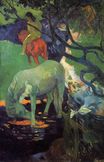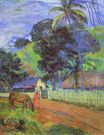Paul Gauguin - The White Horse 1898
 |
 |
 |
 |
 |
 |
 |

The White Horse 1898
140x91cm oil/canvas
Musée d'Orsay, Paris, France
The image is only being used for informational and educational purposes
<< Previous G a l l e r y Next >>
From Musée d'Orsay, Paris:
Gauguin painted this famous picture during his second stay in Tahiti. He liked to roam through the countryside and explore the mountains and forests of the interior. These out-of-the-way places swarmed with all sorts of wildlife and plants which enchanted him.
But this scene is not taken from real life; it is an imaginary, synthetic vision of a Tahitian landscape. The contorted branches of a native tree called bourao, a sort of hibiscus, along with lilies and imaginary flowers in the foreground make a decorative frame for the main motif. The sky and the horizon are locked out of this enclosed space.
A white horse, its coat tinged with the green of the vegetation, has given the painting its title. It is drinking, standing in the middle of a stream which flows vertically through the composition. The solitary animal probably has a symbolic meaning related to the Tahitians' beliefs about the passage of the soul into another world. In Polynesia, white is associated with death and worship of the gods.
Behind the sacred animal, two nude figures are riding bareback into the distance. The tiered arrangement of these three animated motifs in the landscape accentuates the vertical, flat vision of the scene. To intensify the decorative effect, Gauguin has used a sumptuous palette. The greens – from grass green to emerald – and the deep blues contrast with orange and pink notes and the coppery colour of the riders' skin.
An impression of paradisiacal serenity emanates from this canvas which has become a veritable icon. The pharmacist in Tahiti who commissioned the picture did not appreciate Gauguin's daring use of colour. He refused it on the grounds that the horse was too green.